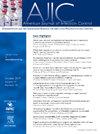Clean Hands are Caring Hands: Improving Anesthesia Provider Hand Hygiene and Double Glove Compliance During Induction of General Anesthesia.
IF 3.8
3区 医学
Q2 INFECTIOUS DISEASES
引用次数: 0
Abstract
BACKGROUND Hand hygiene and double gloving practices during induction of general anesthesia can decrease transmission of bacteria to patients and subsequent healthcare associated infections; however, compliance to these practices is low. METHODS A pre/post-implementation quality improvement design was used with Plan-Do-Study-Act cycles. Several implementation strategies were used to improve hand hygiene and double glove compliance among anesthesia providers, including printed educational materials, video, in-person, and virtual meetings, visual reminders, audit and feedback, and improved access to hand sanitizer dispensers in the anesthesia workstation. RESULTS Average hand hygiene compliance increased from 0% to 11.8% and double gloving compliance increased from 18.5% to 34.5%. A decrease in surgical site infections was shown in the post-implementation period. DISCUSSION Although hand hygiene and double gloving practices increased after the initial implementation, the improvements were not sustained long-term. Practices to support sustainability, such as routine booster sessions, may be considered. CONCLUSIONS Incorporating these quality improvement measures into practice may improve anesthesia provider hand hygiene compliance during induction of general anesthesia and impact subsequent infection rates.干净的手是充满关爱的手:改善麻醉师在全身麻醉诱导过程中的手部卫生和双层手套合规性。
背景在全身麻醉诱导过程中,手部卫生和双层手套的使用可以减少细菌对患者的传播,从而减少后续的医疗相关感染;然而,这些操作的依从性却很低。方法采用 "计划-实施-研究-行动 "循环的实施前/实施后质量改进设计。结果平均手部卫生依从性从 0% 提高到 11.8%,双层手套依从性从 18.5% 提高到 34.5%。讨论虽然手部卫生和双层手套的使用率在最初实施后有所提高,但这种提高并没有长期持续下去。结论将这些质量改进措施纳入实践可能会提高麻醉提供者在全身麻醉诱导期间手部卫生的依从性,并影响后续感染率。
本文章由计算机程序翻译,如有差异,请以英文原文为准。
求助全文
约1分钟内获得全文
求助全文
来源期刊
CiteScore
7.40
自引率
4.10%
发文量
479
审稿时长
24 days
期刊介绍:
AJIC covers key topics and issues in infection control and epidemiology. Infection control professionals, including physicians, nurses, and epidemiologists, rely on AJIC for peer-reviewed articles covering clinical topics as well as original research. As the official publication of the Association for Professionals in Infection Control and Epidemiology (APIC)

 求助内容:
求助内容: 应助结果提醒方式:
应助结果提醒方式:


